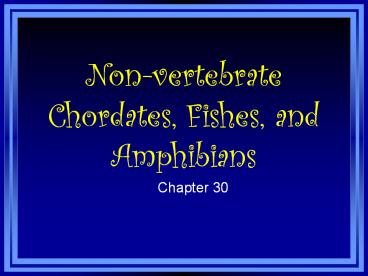Non-vertebrate Chordates, Fishes, and Amphibians PowerPoint PPT Presentation
Title: Non-vertebrate Chordates, Fishes, and Amphibians
1
Non-vertebrate Chordates, Fishes, and Amphibians
- Chapter 30
2
Phylum Chordata
- Contains three sub-phyla
- Vertebrata
- Urochordata
- Cephalochordata
- All chordates at some point in their life span
must possess four characteristics
3
- A hollow, dorsal nerve cord
- A notochord (supporting rod)
- Pharyngeal gill slits
- A tail that extends beyond the anus
4
Urochordates
- Also known as the tunicates or sea squirts
- Basically a sack with two siphons.
5
Cephalochordates
- Examples amphioxus and lancelets
6
Vertebrates
- Most numerous chordates
- Anterior, large brain
- Jointed internal skeleton
- Usually two pairs of appendages and some type of
tail - Closed circulatory system
- Gills or lungs and a chambered heart
7
7 major classes of vertebrates
- Jawless fishes, cartilaginous fishes, bony
fishes, amphibians, reptiles, birds, mammals - Ectotherms cold-blooded body temp changes
with the environment. - Endotherms warm blooded body tem remains
fairly constant
8
FISH or FISHES
- Both words can be used for the plural of a fish.
- Fishes is often used when talking about
taxonomy or classification.
9
1. Class Agnatha
- jawless fishes
- Most primitive vertebrates
- No scales nor fins
- Cartilage skeleton
- No jaws
- Both fresh and salt water varieties.
- examples lampreys and hagfish
10
LAMPREY
- Both fresh and salt water. (parasitic)
- Possess a tongue with teeth that gnaw a hole in
its victim then sucks out the blood. - Can be harmful to fish populations.
11
HAGFISH
- Only found in salt water. scavengers
- Also known as slime eels
- Produce great amounts of slime for defense. Can
tie themselves in a knot
12
2. Class Chondricthyes
- Chondros (Gr. Cartilage)
- Ichthys (Gr. Fish)
- Mostly marine
- 2 chambered heart
- Movable upper and lower jaws
- ex. Sharks, skates, and rays
13
Skates and rays
- Flattened body (countershading)
- Eat worms, mollusks, and other invertebrates
- Can be specialized for defense
- Stingers
- Electric rays
14
SHARKS
- Internal fertilization.
- Viviparous live birth
- Need to be constantly swimming to keep water
moving over the gills - Very highly developed sense of smell.
- Covered with sandpaper-like scales called placoid
scales.
15
Medicinal uses
- Currently shark cartilage is being tested as a
possible cure for cancer.
16
3. Class Osteicthyes
- Osteo- Gr. Meaning bone
- Known as the bony fishes
- Largest class of vertebrates.
- Vary in size, shape, and structure.
- Complex nervous system (lateral lines)
- Very specialized.
- Electric eel, pufferfish, angler fish, butterfly
fish
17
Wide Variety
18
Structure of a bony fish
- Usually four pairs of gills covered by a bony
flap (operculum) - 2 chambered heart
- Many have scales and fins
- Swim bladder gas-filled sac which is used for
buoyancy (maintain depth)
19
Reproduction
- External.
- A female will lay upto 500,000 eggs.
- The male usually swims over the eggs depositing
milt (sperm containing fluid)
20
The Coelacanth
- A special fleshy-lobed finned fish thought to be
extinct. - 1938 one was caught off the southern coast of
Africa.
21
4. Class Amphibia
- from water to land
- Reproduction and development must take place in
or near water. - Thin moist skin
- Two pairs of limbs, one pair of nostrils
- 3 chambered heart
- Young show a distinct larval form.
22
Examples
axolotl
mudpuppy
Frogs
salamanders
23
Frog anatomy and function
- Large powerful hind legs for jumping.
- 2 large movable eyes
- Tympanic membrane
- 3 eyelids
- Upper
- Lower
- Nictitating membrane (transparent used for
underwater sight.
24
digestion
- Large mouth.
- Long sticky spade-shaped tongue
- Teeth along upper jaw.
- A pair of vomerine teeth used to hold prey in
mouth - Esophagus...stomach...small intestine(site of
absorption)..large intestine...cloacaanal
opening.
25
Circulatory system
- Oxygenated blood enters left atrium from lungs.
Deoxygenated blood enters right atrium from rest
of body. - Both empty into ventricle where a mixture of
oxygen and non-oxygen blood is pumped out
26
Respiratory system
- Tadpoles use gills to breathe.
- Adult frog uses three structures for respiration.
skin
Lungs
Lining of the mouth
27
Nervous system
- Possess both a cranial and peripheral nervous
system - Multi-lobed brain
- Olfactory(smell)
- Optic(sight)
- Cerebrum(voluntary muscles)
- Cerebellum(coordination)
- Medulla(involuntary muscle action)
28
Excretory system
- CO2 excreted through the skin, other wastes
filtered through the kidneys. - Urine is stored in urinary bladder then passed
into cloaca and out of the body.
29
Reproduction
- External fertilization
- amplexus male grasps female, eggs are released
then quickly fertilized by the male.
30
Order Urodela
- Salamanders and newts
- Long bodies and tails
- Live in dark, moist places.
31
Orders Anura Apoda
- ANURA
- Frogs and toads
- APODA
- Caecilians
- Legless amphibians
32
Assignment
- Pages 793-794
- 1-10, 14, 17, 18, 20, 23, 24, 28
- Page 795 1-10

